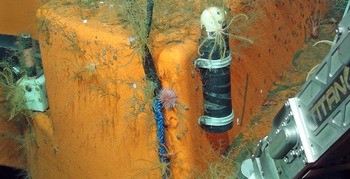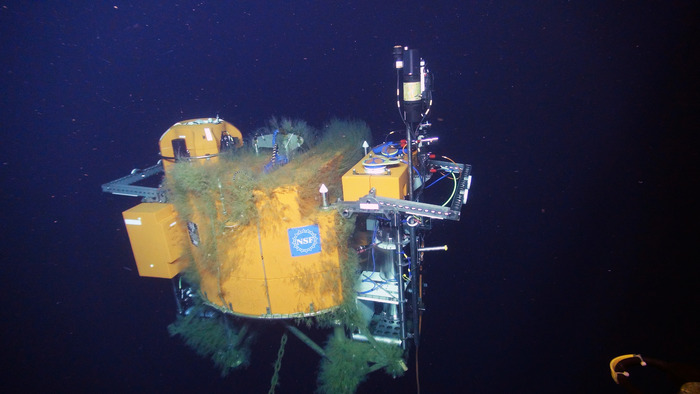
The mooring platform at the Oregon Offshore Site (~600 ft beneath the oceans' surface) abounds with life, supported by the nutrient-rich waters that characterize this area. Small crabs, urchins, and sea stars have colonized the platform since installed in 2014 during the VISIONS'14 cruise. Credit: UW/NSF-OOI/WHOI; J2-919, V16.
Since our ‘weather day’, the crew onboard the R/V Sikuliaq have been extremely busy with operations running around-the-clock. Our time at sea is a once-a-year opportunity we have to conduct the annual maintenance of infrastructure and instruments, as well as to conduct CTD water casts and fluid sampling for data verification of sensors installed on the cable. It is an amazing dance that happens between managing the teams on/off watch schedules, installing and recovering equipment from the seafloor, making sure everything is tied down and in its proper place on the deck, and insuring the team gets sleep – often, we put in 18 hr days – ‘cat naps’ are a gift.
Since Jason Dive 913 when the low-power junction box was installed at the Slope Base site at the base of the Cascadia Margin, we have:
- Recovered and reinstalled 75 instruments from depths as great at 9500 ft beneath the ocean;
- Recovered the medium-powered junction box from Slope Base. Jason Dive J2-914;
- Recovered and reinstalled the Platform Interface Assembly and winched Science Pod at the Slope Base Site; Jason Dives J2-915-917;
- Conducted three CTD casts for measurement of ocean properties and sampling of fluids for follow-on shore based analyses important for instrument verification;
- Recovered and reinstalled the Platform Interface Assembly and winched Science Pod at the Oregon Offshore Site and conducted detailed surveys of two of the mooring legs to check their condition (all look good). Jason Dives J918-920.
The Jason team worked hard to provide fast turn arounds of the vehicle, which allowed us to rapidly get back into the water – weather can change very fast at sea, so when weather is good, all go full out to safely get gear on and off the seafloor.
With the turn of the Shallow Profiler infrastructure at the Oregon Offshore site in the wee hours of yesterday, ALL objectives for Leg 1 of the VISIONS’16 Cabled Array cruise were completed!
With this work done, we turned our attention to using the good weather to get a bit ahead of schedule in preparation for Leg 2 – again attentive to weather changes we may face.
Last night, during Jason Dive J2-921, we surveyed the very active methane seep site called Southern Hydrate Ridge. This area is highly dynamic with large collapse sites marking degassing of methane hydrate from beneath the seafloor, and formation of new, hummocks – presumably indicating new sites of methane hydrate deposition in the subsurface.
During the beginning of the dive, the main study site ‘Einstein’s Grotto' was imaged in detail – the pit marking the venting site had grown several meters since last year, and newly formed hummocky areas were covered by thick, white microbial mats. The elevator was used to take a replacement digital still camera to the seafloor, as well as a replacement flow meter to measure the flow of fluids in and out of the thick sediment pile at this site. The camera was replaced as well as the flow meter.
Once the instruments were placed back in the elevator for recovery to the surface, two University of Washington students from the School of Oceanogrpahy, Brendan Philip and Katie Bigham, lead a detailed survey of an extensive collapse area a couple hundred meters to the north of Einstein’s Grotto – Smokey Caverns. We looked in awe at this site at ~ 2400 ft water depth – it is completely unrecognizable from last year when methane hydrate was exposed on the seafloor. Much of the collapse zone is now marked by more subdued topography resulting from slumping of significant sediment deposits into the collapse zone. Similar to last year, methane bubbles were still streaming from the seafloor, but areas of newly formed, thick microbial mats were in abundance that were not observed last year.
Today we are working at the Oregon Offshore site, suctioning out sediment from around a wet-mate connector so that we can reinstall a camera at this site.We will also be conducting several CTD casts. This evening, we will conduct an exploratory dive at the Pythias Oasis site discovered on the VISIONS’15 OOI-UW cruise.


